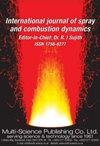Nonlinear analytical flame models with amplitude-dependent time-lag distributions
IF 2.1
4区 工程技术
Q3 ENGINEERING, MECHANICAL
International Journal of Spray and Combustion Dynamics
Pub Date : 2018-12-01
DOI:10.1177/1756827717728056
引用次数: 12
Abstract
In the present work, we formulate a new method to represent a given Flame Describing Function by analytical expressions. The underlying idea is motivated by the observation that different types of perturbations in a burner travel with different speeds and that the arrival of a perturbation at the flame is spread out over time. We develop an analytical model for the Flame Describing Function, which consists of a superposition of several Gaussians, each characterised by three amplitude-dependent quantities: central time-lag, peak value and standard deviation. These quantities are treated as fitting parameters, and they are deduced from the original Flame Describing Function by using error minimisation and nonlinear optimisation techniques. The amplitude-dependence of the fitting parameters is also represented analytically (by linear or quadratic functions). We test our method by using it to make stability predictions for a burner with well-documented stability behaviour (Noiray's matrix burner). This is done in the time-domain with a tailored Green's function approach.具有振幅相关时滞分布的非线性火焰分析模型
在本工作中,我们提出了一种用解析表达式表示给定火焰描述函数的新方法。基本想法的动机是观察到燃烧器中不同类型的扰动以不同的速度传播,并且扰动到达火焰时会随着时间的推移而扩散。我们为火焰描述函数开发了一个分析模型,该模型由几个高斯的叠加组成,每个高斯的特征是三个与振幅相关的量:中心时滞、峰值和标准差。这些量被视为拟合参数,并通过使用误差最小化和非线性优化技术从原始火焰描述函数中推导出来。拟合参数的振幅依赖性也被解析表示(通过线性或二次函数)。我们通过使用我们的方法对具有充分记录的稳定性行为的燃烧器(Noiray矩阵燃烧器)进行稳定性预测来测试我们的方法。这是通过量身定制的格林函数方法在时域中完成的。
本文章由计算机程序翻译,如有差异,请以英文原文为准。
求助全文
约1分钟内获得全文
求助全文
来源期刊

International Journal of Spray and Combustion Dynamics
THERMODYNAMICS-ENGINEERING, MECHANICAL
CiteScore
2.20
自引率
12.50%
发文量
21
审稿时长
>12 weeks
期刊介绍:
International Journal of Spray and Combustion Dynamics is a peer-reviewed open access journal on fundamental and applied research in combustion and spray dynamics. Fundamental topics include advances in understanding unsteady combustion, combustion instability and noise, flame-acoustic interaction and its active and passive control, duct acoustics...
 求助内容:
求助内容: 应助结果提醒方式:
应助结果提醒方式:


